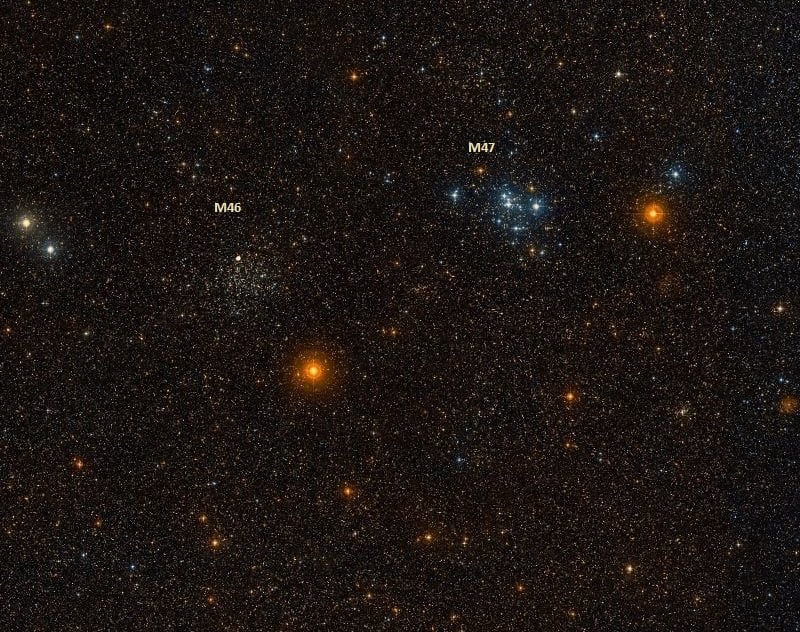Welcome back to Messier Monday! In our ongoing tribute to the great Tammy Plotner, we take a look at Orion's Nebula's "little brother", the De Marian's Nebula!
During the 18th century, famed French astronomer
Charles Messier
noted the presence of several "nebulous objects" in the night sky. Having originally mistaken them for comets, he began compiling a list of them so that others would not make the same mistake he did. In time, this list (known as the
Messier Catalog
) would come to include 100 of the most fabulous objects in the night sky.
One of these objects is the open star cluster known as Messier 47 (NGC 2422), which is located in the
constellation of Puppis
roughly 1,600 light-years from Earth. Located in proximity to Messier 46, this star cluster is estimated to be 78 million years in age. It is also particularly bright, containing about 50 stars and occupying a region that is about the same size as that of the full Moon.
Description:
Spanning across about 12 light years of space, this clump of around 50 stars began their life around 78 million years ago. Now cruising through space some 1600 light years away from Earth, the group continues to distance itself from our solar system at a speed of 9 kilometers per second. For the most part, Messier 47 is a whole lot like the Pleiades star cluster - its brightest member shining just around magnitude 6 and holding a spectral class B2.
But, here you will also find two orange K giants with luminosity of about 200 times that of the Sun. At M47's center you'll find binary star, Sigma 1121, with components of magnitude 7.9 both and separated by 7.4 arc seconds. How do we know that M47 is a lot like the Pleiades? Let's try X-ray sources and the advances of looking at open clusters far more differently than in optical wavelengths. As M. Barbera (et al) said in a
2002 study
:
What else might be hiding inside Messier 47? Try new debris disk candidates. As Nadya Gorlova (et al) indicated in a
2004 study
:
[caption id="attachment_136117" align="aligncenter" width="580"]
Iof the star cluster Messier 47 taken by the Wide Field Imager camera on the 2.2-metre telescope at ESO's La Silla Observatory in Chile. Credit: ESO
[/caption]
History of Observation:
Messier 47 was originally discovered before 1654 by Hodierna who described it as:
However, it was one of those very rare circumstances when Messier actually made a mistake in his position calculations. Despite this error, the cluster was observed by Caroline Herschel and identified as M47 at least twice in early 1783.
As a consequence of Messier's position mistake, Sir William Herschel also independently rediscovered it on February 4, 1785, and gave it the number H VIII.38. "A cluster of pretty compressed large [bright] and small [faint] stars. Round. Above [more than] 15' diameter." It would be John Herschel, on December 16, 1827, who would be the first to resolve Sigma 1121: "The chief star of a large, pretty rich, straggling cluster. It [the star] is double."
[caption id="attachment_136118" align="aligncenter" width="580"]
Atlas Image mosaic obtained of Messier 47 as part of the Two Micron All Sky Survey (2MASS). Credit: UMass/IPAC/Caltech/NASA/NSF
[/caption]
The "Messy" mistake would haunt star catalogs - including both Herschel's and Dreyer's for years, until the whole clerical error was cleared up by Owen Gingerich in 1960:
May you have Caroline Herschel's luck finding it!
Locating Messier 47:
There is no simple way of finding Messier 47 in the finderscope of a telescope, but it's not too hard with binoculars. Begin your hunt a little more than a fist width east/northeast of bright Sirius (Alpha Canis Majoris)... or about 5 degrees (3 finger widths) south of Alpha Monoceros. (It can sometimes by seen with the unaided eye under good conditions as a dim nebulosity.) There you will find two open clusters that will usually appear in the same average binocular field of view.
[caption id="attachment_136115" align="aligncenter" width="461"]
Messier 47 location. Image: IAU and Sky & Telescope magazine (Roger Sinnott & Rick Fienberg)
[/caption]
M47 is the westernmost of the pair. It will appear slightly brighter and the stars will be more fewer and more clearly visible. In the finderscope it will appear as if it is resolving, while neighboring eastern M46 will just look like a foggy patch. Because M47's stars are brighter, it is better suited to less than perfect sky conditions, showing as a compression that begins to resolve in binoculars and will resolves almost fully even a small telescope.
And here are the quick facts on this Messier Object to help you get started:
- Object Name
-
Messier 47
- Alternative Designations
-
M47, NGC 2422
- Object Type
-
Open Galactic Star Cluster
- Constellation
-
Puppis
- Right Ascension
-
07 : 36.6 (h:m)
- Declination
-
-14 : 30 (deg:m)
- Distance
-
1.6 (kly)
- Visual Brightness
-
5.2 (mag)
- Apparent Dimension
-
30.0 (arc min)
We have written many interesting articles about Messier Objects here at Universe Today. Here's Tammy Plotner's
Introduction to the Messier Objects
, ,
M1 – The Crab Nebula
,
M8 – The Lagoon Nebula
, and David Dickison's articles on the
2013
and
2014
Messier Marathons.
Be to sure to check out our complete
Messier Catalog
. And for more information, check out the
SEDS Messier Database
.
Sources:
 Universe Today
Universe Today
